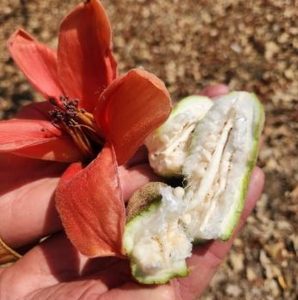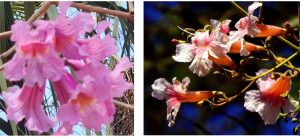
TREE LIFE 530
OCTOBER 2024
PLANNED EVENTS:- OCTOBER
Since inclement weather or other issues may vary our plans, WhatsApp Tony Alegria on 0772 438 697 to join our WhatsApp group for last-minute updates.
Saturday 5th October 2024:- visit to the National Botanic Gardens. This event has been cancelled since a large number of regular members are taking part in the exciting week’s expedition to the Matabele region of Zimbabwe. You can read all about this in the next issues of Tree Life and meanwhile enjoy the warmer weather and the flowering trees.
Main meeting Sunday 20th October 2024:- We will be visiting Doon Estates. Take Samora Machel Road out of town and 3.6 km from the Glenara Road intersection turn into Falice Avenue. Head past Bathroom Boutique towards Chapungu Sculpture Garden where the road becomes Harrow Road and meet at the entrance to Doon estate at 9.30 a.m. Please watch your WhatsApp for further details.
REPORTS FROM PREVIOUS OUTINGS
NATIONAL BOTANIC GARDEN OUTING:- SATURDAY 7TH SEPTEMBER 2024
By Linda and Mark Hyde, photos from Jim Dryburgh and Linda Hyde

From left to right: Sonya Messick, Mark Hyde Stuart Wood, Jim Dryburgh Charles Crawshaw, Jan Van Bel
On a warm Saturday morning, Mark and I were delighted to be joined by Stuart Wood, Charles Crawshaw, Jim Dryburgh, Sonya Messick, Jan Van Bel, and later, Busi Malunga. We missed many of our regulars. I started to think who you were and realised how many people enjoy these morning walks. Our aim was to see trees with distinctive flowers and fruit, avoiding the other tantalising species.

Schotia brachypetala or Weeping boerbean
The first certainly fell into the category of distinctive, the Schotia brachypetala or Weeping boerbean – it produces so much nectar that it simply weeps. It is a bean so it produces bean like pods, the leaves are paripinnate and it has a flattened leafstalk.
Moving on we saw flowering Cassia abbreviata, the fallen single specimen of Commiphora ugogensis, Cordyla africana, Acacia nigrescens but the 5-winged fruits of the scrambling Combretum obovatum proved impossible to catch on camera.
The pendulous flowers of the Kigelia africana did, however, produce some interesting features, in particular the dwarf 5th sterile stamen (known as a staminode) while great fun was had to try to find and fly the helicopter fruits of the Gyrocarpus americanus subsp, africanus.

Kigelia africana with the staminode highlighted in the oval Gyrocarpus americanus subsp. africanus

Albizia anthelmintica, the Worm Cure Albizia
The fluffy balls of Albizia anthelmintica, the Worm Cure Albizia, were going over but still helped identify the plant. A preparation of the bark and shoots is effective against internal parasites, especially tapeworm (hence the name, helminth being the name for the helmis worm). In Somalia, the tree is said to provide a cure for gonorrhoea and the roots are cooked in chicken broth.
We then saw the red flowers of both Combretum microphyllum scrambling at ground level and Combretum paniculatum silhouetted against the sky.

Delonix decaryi
Walking towards the herbarium we saw what we thought was a baobab or baobab relative, maybe one from Madagascar but no. Mark told us that while the country was correct it was actually a Delonix decaryi, an endemic species of flamboyant. The narrowing of the base below the cigar shaped body is very distinctive and makes the tree look unstable.
At the back of the Herbarium Mark pointed out the Spekboom, Portulacaria afra, and the Jade bush, Crassula ovata. These are easily confused until they flower, the Spekboom having bright pink, erect spikes in summer while the Jade bush has small star shaped flowers in winter.

Spekboom spikes with buds Spekboom left and Jade bush bottom right Jade bush with dead flowers

Marsdenia abyssinica
The stems of the Spekboom are red turning to brown as they age and have numerous health benefits due to the high vitamin C and tannin content. Both are native to the Eastern Cape (where Spekboom is also the staple food of elephants) through to Mozambique.
Our next striking plant was the climber Marsdenia abyssinica. This species belongs to the family Apocynaceae and bears paired fruits which open at 180° to each other. The outside of the fruit looks as if it has been cooked in breadcrumbs, although in the textbooks this surface is described as “bearing numerous convoluted wings”. It is a widespread species in tropical Africa but not common around Harare – perhaps it had been planted in the Botanic Gardens?

Bombax ceiba
Close by was a single specimen of Bombax ceiba from the family Malvaceae. It is a relative of the baobab and also the various species of kapok we see often around the city. I (Mark) was not sure until recently whether it had the kapok material in its pods, but it was clear from this tree that it does.
Passing the beautiful Fernandoa abbreviata, Combretum paniculatum, an unknown succulent with Strophanthus-like pods, a monkey puzzle, Pterocarpus angolensis (the fruit being known in our family as the egg fruit) we came across Handroanthus impetiginosus also known as tabebuia or pink trumpet tree and easily confused with the nearby Stereospermum kunthianum or pink jacaranda. The rather irreverent way to remember the Handroanthus species name is to convert impetiginosus to “I pick the nose”!

Handroanthus impetiginosus or pink trumpet tree Stereospermum kunthianum or pink Jacaranda
Lannea discolor and Combretum hereroense (the mouse eared combretum), both in flower, finished a fascinating walk.
Saturday 28th September 2024:- visit to Athol Evans.
Unfortunately I need to send this out before receiving a report on this outing. Read the next issue to read out about our findings.
And now for some more notes from around Harare …
Usambara Dock in Harare and elsewhere
Text and photos Ian Riddell

iNaturalist records around Harare
I recently (September 2024) noticed a clump of Usambara Dock Rumex usambarensis growing on the edge of Borrowdale racecourse, on the edge of a small vegetable garden outside the fence of Karl’s veterinary practice (A on the map from iNaturalist records). Following up on how it got there, one of Karl’s employees said he was ‘not the one’, and that I should speak to the employee of Bargrove Veterinary Group (BVG), tucked into the corner of the same property.
The man in question said he had planted it from some ‘sticks’ obtained from Mbare, though he referred to the Chitungwiza roundabout on the Masvingo road, so that sounds like more Waterfalls than Mbare.
The Rumex at Epworth is written about in Tree Life 488. I later found a large hedge in Seke near the airport in August 2022 (I). This was planted at the bottom of the wall of Butler’s dam as a fence around a vegetable garden and the stems were quite substantial, so it has been there quite a long time.
A lot was growing just off the Mutare road in Ventersburg (C) in September 2023 on the Delport road dirt track. The area was a bit of a soak zone and it may have been ‘natural weed’ there.
Recently, July 2024, I happened across a bush on the Harare Drive road verge with Ricinus communis (the dominant ‘weed’) on the edge of Falcon Golf Club (B). This definitely looked like it had established itself.

Rumex usambarensis – flowers Rumex usambarensis – fruit
I have also seen it used for hedges on the edge of Epworth off Twentydales road, just north of Kutsaga, and suppose I should map these on iNaturalist, too.

Rumex usambarensis at BVG
So it seems that this Rumex is more widespread than first reported and it is known as a hedge plant. The BVG man knew of its use as a hedge and it seems likely that it is planted as such in the high-density suburbs of south Harare.
Elsewhere, I have recently seen it used as a hedge outside a house in Mvurwi and again on the main road heading north out of Mvurwi in the high-density suburb. I never stopped to map these last localities, but I wonder where else around the country it has been planted?

From ZimFieldGuide.com
“Tree Society members
enjoying a walk and some
tree identification with
Tony Alegria and Meg
Coates Palgrave” date
unknown
Devastated woodland on the road to Harava (Henry Hallam) Dam
By Mark Hyde
On Tuesday, 27 August 2024, Tony Alegria, Jan van Bel and I went on a recce to Harava (Henry Hallam) Dam to investigate the location as a possible place for a Tree Society outing. Things have changed at the turn-off from the Seke Road; the old way is now closed, and it took a while to find the new entry point at a boom gate.
The road to the dam heads eastwards to the north of the river for c. 4.5 kms to the dam wall. On my last visit, the road passed through thick shady woodland mixed with tall anthills, somewhat reminiscent of the woodland at Lake Chivero. Occasionally, where a stream crossed the road, it would open out and there would be a sunny patch.
Now, almost all the trees have been logged, mostly at about 50 cm – 1 m in height. Axes seemed to have been used but also some chain saws. In between the stumps, there is some regrowth although in many cases that had been cut as well. The road is now completely open and the vegetation remaining is a sort of scrub.

Harava Dam (formerly Henry Hallam Dam) woodland – August 2024
The two images show:
- a view along the road showing the open scrub with a large exposed anthill on the left;
- picture of tree stumps, residual small trees with Chitungwiza in the distance.
Most of the tree species are still there, but because of the unfortunate comparison with its former state it was decided not to hold a Tree Society outing there in the near future.
TREE SOCIETY COMMITTEE AND CONTACTS
Chairman Tony Alegria tonyalegria47@gmail.com 0772 438 697
Vice Chairman Mark Hyde mahyde@gmail.com 0772 233 751
Honorary Treasurer Bill Clarke wrc@mweb.co.zw 0772 252 720
Secretary Teig Howson teig.howson@gmail.com 0772 256 364
Venue Organiser Ann Sinclair jimandannsincs@zol.co.zw 0772 433 125
Committee Member Jan van Bel jan_vanbel@yahoo.com 0772 440 287
Committee Member Ryan Truscott ryan.kerr.truscott@gmail.co 0772 354 144
Committee Member Sibusiso Malunga busimalunga@yahoo.com 0775 889 898
Tree Life Editor Linda Hyde Lmharwin@pentact.co.zw 0772 232 075
Tree Society Website https://treesociety.org.zw/
Tree Society Facebook https://www.facebook.com/groups/ztreesociety/
Flora of Zimbabwe: https://www.zimbabweflora.co.zw/
Flora of Tropical Africa: https://plants.jstor.org/collection/FLOTA


